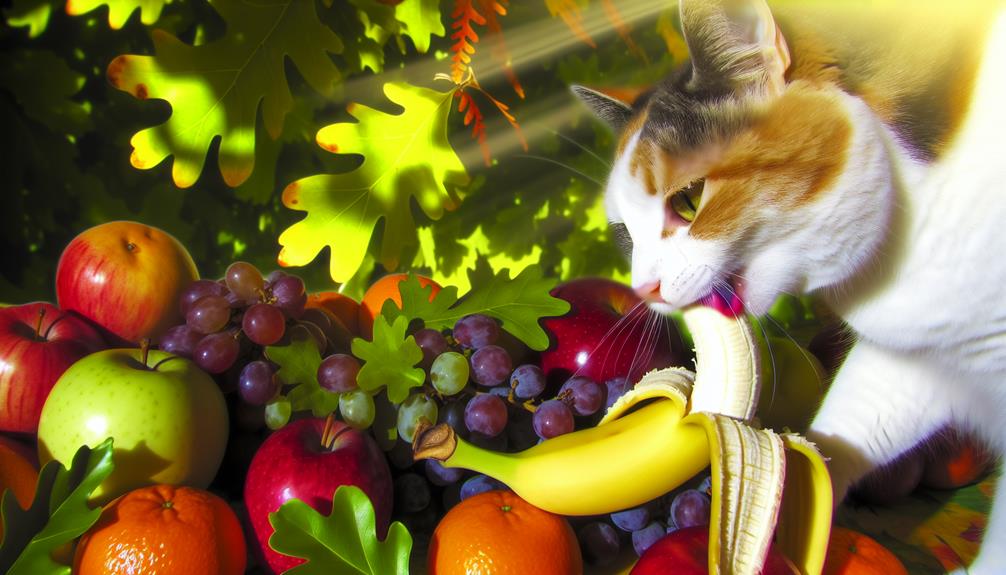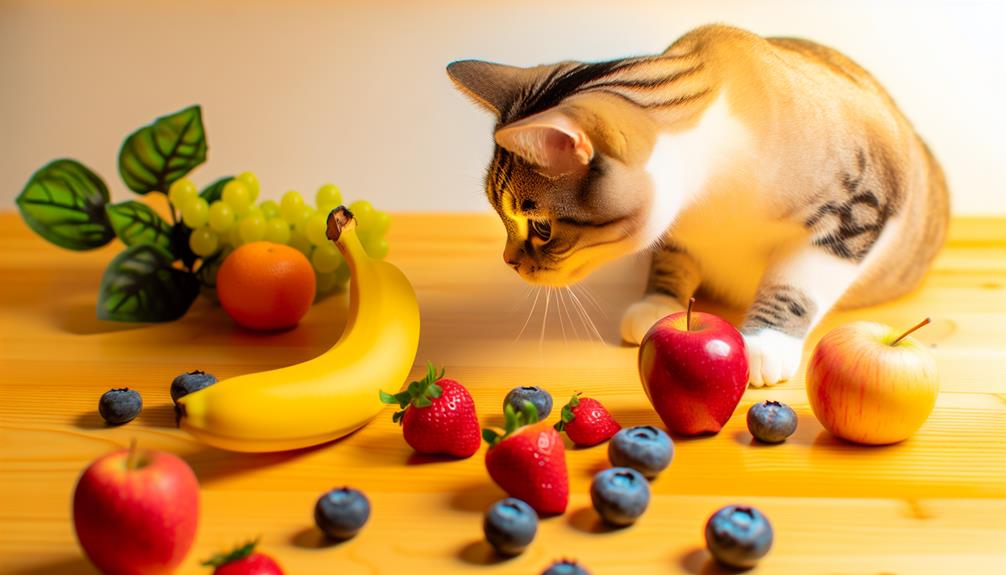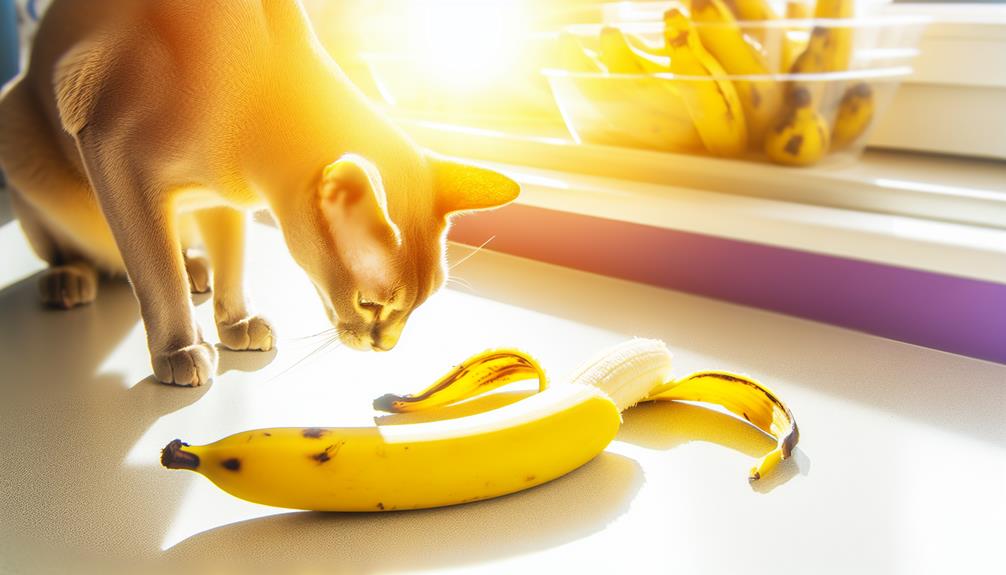You might be wondering if it's safe to share a banana with your cat. While bananas aren't toxic to cats, their digestive systems aren't exactly built for plant-based foods. Offering a small piece as an occasional treat can be fine, but it's essential to monitor how your cat reacts. There are potential benefits, like added dietary fiber, but also risks such as gastrointestinal upset. So, how can you safely introduce bananas into your cat's diet, and what signs should you look out for? Let's explore this further to guarantee your feline friend stays healthy and happy.
Nutritional Value of Bananas
Bananas, a common fruit in many households, offer a range of nutritional benefits that can be fundamental for both humans and animals. When considering the nutritional value of bananas, it's important to understand their composition and how they might affect feline digestion. Bananas are rich in essential nutrients such as potassium, magnesium, vitamin B6, and dietary fiber. These nutrients play significant roles in maintaining overall health.
The banana composition includes approximately 105 calories per medium-sized fruit, with about 27 grams of carbohydrates, 3 grams of fiber, and 14 grams of sugar. The high potassium content is particularly significant; potassium is critical for maintaining proper muscle function and electrolyte balance. Additionally, magnesium aids in nerve function and muscle relaxation, while vitamin B6 is fundamental for protein metabolism and cognitive development.
However, when it comes to feline digestion, it's important to remember that cats are obligate carnivores. This means their digestive systems are optimized for processing animal proteins rather than plant-based foods. The dietary fiber in bananas, while beneficial for human digestion, can be difficult for cats to process. Their shorter gastrointestinal tracts aren't designed to break down complex carbohydrates and plant fibers efficiently.
Despite these challenges, the small amounts of sugar and fiber in bananas are generally manageable for a cat's digestive system in moderation. It's essential, though, to monitor how your cat responds to any new food. The unique composition of bananas can offer some nutritional benefits, but it should never replace a balanced, meat-based diet specifically formulated for feline health. Always consult with a veterinarian before making any dietary changes for your cat.
Are Bananas Safe for Cats?
Have you ever wondered if giving your cat a banana is safe? The good news is that bananas are generally not toxic to cats. That said, it's essential to understand the nuances of feline digestion and how it differs from ours. Cats are obligate carnivores, meaning their digestive systems are optimized for meat consumption, not fruits or vegetables. While bananas do not pose a direct risk of banana toxicity, they should still be offered sparingly.
One key point to take into account is that cats lack certain enzymes necessary for efficiently digesting plant-based foods. This inefficiency can lead to gastrointestinal upset if your cat consumes a significant amount of banana. Common symptoms might include vomiting, diarrhea, or even constipation. It's always prudent to start with a very small piece to see how your cat's digestive system reacts.
Moreover, bananas contain a considerable amount of sugar, which isn't ideal for feline consumption. High sugar intake can contribute to obesity and diabetes over time, conditions that are challenging to manage in cats. Given that bananas are not a natural part of a cat's diet, they should only be treated as an occasional novelty rather than a regular snack.
Health Benefits

While it's clear that bananas should be offered to cats sparingly due to their digestive limitations, there are some potential health benefits when given in moderation. Bananas are rich in essential nutrients that can be beneficial to your cat's overall health, provided you respect their unique dietary needs and preferences.
Bananas contain high levels of potassium, which is critical for maintaining proper muscle function and nerve transmission. This mineral can support your cat's cardiovascular health and assist in muscle development. Additionally, bananas offer a good source of vitamin B6, which is fundamental for protein metabolism and cognitive function.
Here's a brief overview of some key nutrients in bananas and their potential benefits for cats:
| Nutrient | Potential Benefits for Cats |
|---|---|
| Potassium | Supports muscle function and heart health |
| Vitamin B6 | Aids in protein metabolism and brain health |
| Dietary Fiber | May help with mild digestive issues |
However, it's significant to recognize that cats are obligate carnivores, and their digestive systems are not designed to process large amounts of fruits. The dietary fiber in bananas can contribute to better digestion, but only in very small amounts. Too much fiber can lead to gastrointestinal upset, contradicting the benefits.
In light of feline preferences, some cats might enjoy the soft texture and mildly sweet taste of bananas, while others may turn their noses up at them. Always monitor your cat's reaction and consult with your veterinarian before introducing new foods into their diet. Understanding the intricacies of banana digestion in cats is essential for maximizing any potential health benefits and ensuring your pet's well-being.
Potential Risks
Introducing bananas into your cat's diet comes with potential risks that shouldn't be overlooked. While bananas are generally non-toxic to cats, the concept of banana toxicity arises from overconsumption or adverse reactions. Although bananas aren't inherently harmful, their high sugar content can be problematic. Feline digestion isn't optimized for processing large amounts of sugar, which can lead to gastrointestinal upset, including diarrhea and vomiting.
Another concern involves the fiber content in bananas. While fiber aids in digestion for humans, it can be excessive for cats, whose digestive systems are primarily designed for carnivorous diets. Too much fiber can result in digestive irregularities, such as constipation or bloating, making it vital to monitor any changes in your cat's bowel habits after introducing bananas.
Additionally, the potassium levels in bananas, while beneficial in moderation, could pose a risk if consumed in large quantities. Hyperkalemia, or elevated potassium levels, can lead to muscle weakness, cardiac arrhythmias, and overall lethargy. It's important to verify that your cat isn't getting too much potassium from other sources before offering them bananas.
Some cats may also experience allergic reactions to bananas, albeit rarely. Symptoms can range from mild itching and swelling to severe respiratory issues. If you notice any signs of an allergic reaction, discontinue feeding bananas immediately and consult your veterinarian.
Given these potential risks, it's important to approach feeding bananas to your cat with caution. Always introduce new foods gradually and in small amounts, observing for any adverse effects. Your cat's health should always be your primary concern, and understanding the intricacies of feline digestion can help you make informed dietary choices.
How to Serve Bananas

When serving bananas to your cat, it's crucial to take into account proper portion sizes and safe serving methods to guarantee their health. Limit the portion to small, bite-sized pieces to prevent choking and potential digestive issues. Always serve ripe bananas and avoid any additives or flavorings to maintain their nutritional integrity.
Proper Banana Portion Sizes
Serving bananas to your cat requires careful consideration of proper portion sizes to assure their safety and health. Cats have specific dietary needs and preferences, and bananas aren't a natural part of their diet. Therefore, moderation is vital. Here are some banana serving guidelines to follow:
- Portion Size: Limit the banana portion to a small slice, approximately a quarter-inch thick. This guarantees that your cat doesn't consume too much sugar or fiber, which can disrupt their digestive system.
- Frequency: Offer banana as an occasional treat, not more than once or twice a week. Frequent feeding may lead to nutritional imbalances due to the high carbohydrate content of bananas.
- Observation: Always monitor your cat after introducing a new food item. Watch for any signs of digestive upset, such as vomiting or diarrhea, and discontinue if any adverse reactions occur.
These guidelines are important because cats are obligate carnivores, primarily requiring meat-based nutrients. While they may show curiosity towards fruits like bananas, their dietary preferences and physiological makeup necessitate a cautious approach to any non-meat food items. By adhering to these banana serving guidelines, you can offer your feline friend a safe and occasional treat.
Safe Serving Methods
To guarantee your cat's safety and health when offering banana treats, it's crucial to follow specific serving methods. First, verify proper banana preparation by thoroughly washing the banana's peel to remove any pesticides before peeling it. Only offer small, bite-sized pieces to prevent choking hazards. Cats have small mouths and throats, making large chunks dangerous.
When considering feline preferences, remember that not all cats enjoy the taste or texture of bananas. Introduce the new treat gradually by mixing a small piece with their regular food. Observe your cat's reaction closely; if they show disinterest or adverse effects such as vomiting or diarrhea, cease feeding bananas immediately.
Serving bananas as a puree can be an alternative method. Mash a small piece until smooth and mix it with their usual wet food. This method can make the banana more palatable and easier to ingest. Always use fresh bananas and discard any leftovers to avoid spoilage.
Signs of Allergies
A clear indication of a cat's allergy to bananas can be observed through various clinical signs. Understanding these allergy symptoms is vital for ensuring your feline friend's health and well-being. Cats, like humans, can have allergic reactions to certain foods, and bananas are no exception.
Key Signs of Allergies in Cats:
- Skin Irritations: One of the most common allergy symptoms is skin irritation. If your cat is allergic to bananas, you might notice excessive scratching, redness, or even hair loss in specific areas. Cats tend to groom themselves rigorously in response to skin discomfort, which can exacerbate the issue.
- Gastrointestinal Issues: Allergic reactions can often manifest in the digestive tract. Look out for signs such as vomiting, diarrhea, or a noticeable decrease in appetite. These symptoms indicate that your cat's system is struggling to process the banana, leading to gastrointestinal distress.
- Respiratory Problems: Although less common, some cats may experience respiratory symptoms due to an allergy. This can include sneezing, coughing, or wheezing. Breathing difficulties should never be ignored as they can escalate quickly and require immediate veterinary attention.
It's essential to monitor your cat closely after introducing any new food, including bananas. If you observe any of these signs, discontinue feeding the banana and consult your veterinarian. They can help you determine if the symptoms are indeed linked to an allergic reaction and advise on the best course of action. Early detection and intervention are key to managing food allergies in cats effectively. Remember, your vet is your best resource for evidence-based guidance tailored to your cat's unique health needs.
Other Cat-Friendly Fruits

When considering other cat-friendly fruits, it's crucial to select options that are safe and nutritionally beneficial for your feline companion. Not all fruits are suitable for cats, but incorporating certain types as occasional treats can provide variety and added nutrients. Let's explore some evidence-based options for cat-friendly snacks.
Blueberries are a great choice. They're packed with antioxidants and vitamins, which can support your cat's immune system. Always verify the berries are washed thoroughly and served in small, manageable pieces to avoid choking hazards. Additionally, you can freeze them for a revitalizing summer treat.
Apples, excluding the seeds and core, can serve as another healthy fruit alternative. Apples contain fiber and vitamin C, contributing to overall digestive health and immune function. Slice the apple into small, easily chewable pieces for your cat.
Watermelon is another excellent option, particularly for hydration. This fruit is mostly water, making it a great choice during hot weather. Just be sure to remove any seeds and rind, which can be harmful.
Strawberries can also be included in your list of cat-friendly snacks, although moderation is key due to their sugar content. Strawberries are rich in vitamin C, manganese, and fiber. Serve them in small, bite-sized portions.
Lastly, cantaloupe is a hydrating fruit alternative that many cats enjoy. Rich in vitamins A and C, this fruit can be a delightful and healthy snack. Remove the seeds and rind before offering it to your cat.
Conclusion
To summarize, while cats can eat bananas in moderation, remember that they're obligate carnivores. "Too much of a good thing can be bad," so offer bananas sparingly, monitoring for any adverse reactions. This occasional treat can provide variety and fiber, but overindulgence may upset their delicate digestive systems. Always introduce new foods cautiously and consult your vet if you're unsure. Keep an eye out for allergies, and explore other cat-friendly fruits for added dietary enrichment.
